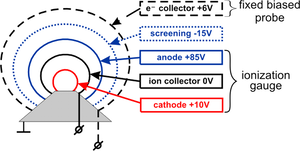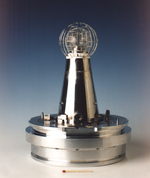CONE instrument
CONE (COmbined sensor for Neutrals and Electrons) is a combination of an ionization gauge and a fixed biased Langmuir probe.
This instrument was developed in the atmospheric physics laboratory of Bonn University, which then moved to the Leibniz-Institute of Atmospheric Physics, in collaboration with the Norwegian Defense Research Establishment (FFI) in Kjeller, Norway. CONE was successfully used in more than 20 sounding rocket flights. See e.g. our turbulence studies.
The outermost grid of the CONE instrument is positively biased and, therefore, it collects electrons and also works as a shield for positive ions. The next grid is negatively biased, and hence, it shields the ionization gauge against the rest of the ambient plasma. The innermost cathode, collecting electrode, and anode form the ionization gauge itself.
Thus, the currents measured by CONE are proportional to the local electron and neutral number densities. The time constant is < 1 ms. For a typical rocket flight this means altitude resolution of ~10 cm. The precision is better than 0.1 %.
Beside the neutral air turbulence studies the CONE detector is used for examination of plasma instabilities and measurements of absolute neutral air densities and temperatures.














